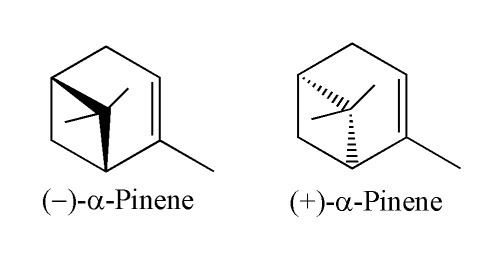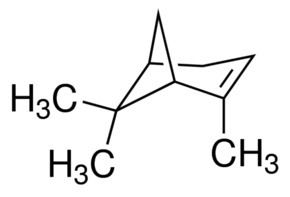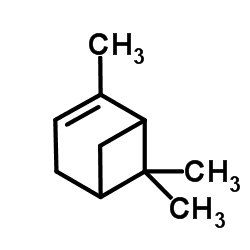Formula C10H16 Appearance Liquid | Molar mass 136.24 g/mol | |
 | ||
Reaction of alpha pinene with iodine
Pinene (C10H16) is a bicyclic monoterpene chemical compound.[1] There are two structural isomers of pinene found in nature: α-pinene and β-pinene. As the name suggests, both forms are important constituents of pine resin; they are also found in the resins of many other conifers, as well as in non-coniferous plants such as camphorweed (Heterotheca) and big sagebrush (Artemisia tridentata). Both isomers are used by many insects in their chemical communication system. The two isomers of pinene constitute the major component of turpentine.
Contents
- Reaction of alpha pinene with iodine
- Scientific analysis report on pinene an off flavor in mango juice
- Biosynthesis
- Plants
- Usage
- References

Scientific analysis report on pinene an off flavor in mango juice
Biosynthesis

α-Pinene and β-pinene are both produced from geranyl pyrophosphate, via cyclisation of linaloyl pyrophosphate followed by loss of a proton from the carbocation equivalent.
Plants
Alpha-pinene is the most widely encountered terpenoid in nature and is highly repellant to insects.

Alpha-pinene appears in conifers and numerous other plants. Pinene is a major component of the essential oils of Sideritis spp. (ironwort) and Salvia spp. (sage). Cannabis also contains alpha-pinene. Resin from Pistacia terebinthus (commonly known as terebinth or turpentine tree) is rich in pinene. Pine nuts produced by pine trees contain pinene.

Makrut lime fruit peel contains an essential oil comparable to lime fruit peel oil; its main components are limonene and β-pinene.
Usage

In chemical industry, selective oxidation of pinene with some catalysts gives many compounds for perfumery, such as artificial odorants. An important oxidation product is verbenone, along with pinene oxide, verbenol and verbenyl hydroperoxide.
Pinenes are the primary constituents of turpentine.

Pinene has also been used as anti-cancer agent in Traditional Chinese medicine, also for its anti-inflammatory, antiseptic, expectorant and bronchodilator properties.
